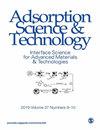以天然粘土和改性粘土为吸附剂部分纯化紫甘蓝中的花青素(芥蓝变种 Rubra
IF 3.2
4区 工程技术
Q2 CHEMISTRY, APPLIED
引用次数: 0
摘要
本研究旨在评估使用天然粘土和改性粘土作为吸附剂吸附和回收紫甘蓝中的花青素的策略。在批量吸附实验中,花青素提取物与吸附剂接触,并对不同参数进行评估,以确定吸附和回收的最佳条件。结果表明,使用多孔粘土异质结构(PCH)材料作为吸附剂,质量为 25 毫克,接触时间为 120 分钟,吸附量最高(28.0 毫克/克-1)。在相同条件下,海泡石的吸附容量仅为 14.0 毫克/克。解吸结果表明,60% 的甲醇溶液回收了 60% 吸附在 PCH 上的花青素,而 80% 的乙醇溶液回收了 35% 吸附在海泡石上的花青素。洗脱后的花青素溶液中的糖浓度比粗提取物低 98%,这表明吸附剂对糖的亲和力较低。通过 UPLC-QToF-MSE 鉴定了提取物中的六种酰化花青素,并通过傅立叶变换红外分析证实,粘土对结构中有机酸含量较高的花青素亲和力最高。结果表明,PCH 和sepiolite 对花青素具有较高的选择性,而对植物提取物中的糖类亲和力较低,有利于这些色素的部分纯化和应用。本文章由计算机程序翻译,如有差异,请以英文原文为准。
Partial Purification of Anthocyanins (Brassica oleracea var. Rubra) from Purple Cabbage Using Natural and Modified Clays as Adsorbent
This research is aimed at evaluating strategies for the adsorption and recovery of anthocyanins present in purple cabbage using natural and modified clays as adsorbent. In the batch adsorption experiments, the anthocyanin extracts were put in contact with the adsorbents, and different parameters were evaluated to determine the best conditions for their adsorption and recovery. It was noted that the highest levels of adsorption (28.0 mg g-1) occurred using a porous clay heterostructure (PCH) material as adsorbent, with a mass of 25 mg and 120 min of contact. Under the same conditions, the sepiolite only presented an adsorption capacity of 14.0 mg g-1. The desorption results showed that the 60% methanolic solution recovered 60% of the anthocyanins adsorbed on PCH, while the 80% ethanolic solution recovered 35% of those adsorbed on sepiolite. The eluted anthocyanin solutions showed a 98% lower sugar concentration than the crude extract, indicating the low affinity of the adsorbents for sugars. Six types of acylated cyanidins were identified via UPLC-QToF-MSE in the extract, and it was confirmed from the FTIR analyses that the highest affinity of the clays occurred with the anthocyanins that presented more organic acid in their structure. The results show that PCH and sepiolite have high selectivity for anthocyanins and low affinity for the sugars present in the plant extract, facilitating the process of partial purification and application of these pigments.
求助全文
通过发布文献求助,成功后即可免费获取论文全文。
去求助
来源期刊

Adsorption Science & Technology
工程技术-工程:化工
CiteScore
5.00
自引率
10.30%
发文量
181
审稿时长
4.5 months
期刊介绍:
Adsorption Science & Technology is a peer-reviewed, open access journal devoted to studies of adsorption and desorption phenomena, which publishes original research papers and critical review articles, with occasional special issues relating to particular topics and symposia.
 求助内容:
求助内容: 应助结果提醒方式:
应助结果提醒方式:


